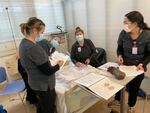Seventeen-year-old Vivian Pham has always been interested in the health care field. But, a few years ago, her sister had appendicitis, and she realized she specifically wanted to be a nurse.

Vivian Pham, 17, is a senior at Benson Polytechnic High School in Portland, Oregon. She's planning on going to the University of Portland to work toward getting a Bachelor of Science in Nursing.
Courtesy of Tram Nguyen / Tram Nguyen
“Even though the doctors were the ones that diagnosed my sister and performed surgery on her, it was really the nurses that had that direct patient interaction,” Pham said. “Just seeing how much care and compassion that nurses put into caring for their patients, it really moved me and made me think, ‘Wow, maybe this is something I’m interested in pursuing.’”
Pham is now a senior at Benson Polytechnic High School in Portland, in the school’s nursing career technical education program, with plans for the fall to pursue a Bachelor of Science in Nursing at the University of Portland.
Like practically every student in the country, the pandemic has upended Pham’s schooling. Instead of being able to shadow nurses in the field and volunteer at clinics, she’s mostly been learning on a computer. But, if anything, she said the pandemic has made her even more passionate about her future profession.
“I feel like, especially during these times, you see headlines and news articles about how there’s a shortage of nurses and how that eventually leads to burnout,” Pham said. “And I feel like for some people they might see that and become scared and anxious and maybe it’s, ‘Nursing’s not for me.’ But personally, I think it makes me want to go into nursing even more.”
The pandemic has put unprecedented pressure on health care providers, especially those working face-to-face with patients like nurses. But, nursing professionals in Oregon are seeing that Pham is not alone: Instead of scaring away would-be nurses, they’ve seen growing interest in their line of work.
Increased passions amid the pandemic
“Interest in nursing has gone sky high during the pandemic,” Kevin Mealy, communications manager with the Oregon Nurses Association, the state’s professional nursing union, said. “People are seeing the incredible work that nurses are doing, and that’s actually becoming a more attractive profession. People are feeling that call.”
But, that increased interest in nursing might not be enough to combat an increasing demand due in part to an aging workforce that’s starting to retire. At the same time, Oregon and other states have a longstanding problem with their nursing pipeline: a lack of faculty and too few program spots for aspiring nurses.
According to the American Association of Colleges of Nursing, in 2019, U.S. nursing schools turned away more than 80,000 qualified applicants from baccalaureate and graduate nursing programs due to a lack of faculty, clinical placements and classroom space.
According to the most recent data from the Oregon Employment Department, over the next 10 years, there will be about 28,600 job openings for registered nurses, in part due to growing demand for health care as the state’s population ages.
In that same time span, if a similar trend continues, Oregon is expecting to see only about 16,000 new registered nurses enter the workforce after completing nursing programs in the state.
Jana Bitton, executive director with the Oregon Center for Nursing, a nonprofit focused on nursing research, said identifying a nursing gap or shortage in the state, isn’t as simple as those numbers.
“If you look at national projections and you look at the national forecast, it sounds like it’s gloom and doom, like we do not have enough nurses,” Bitton said. But, it’s not that black and white, she said.
Prior to the pandemic, there was a good number of people moving to Oregon from out of state and becoming part of the nursing workforce to help balance out any major gaps that have existed on paper, Bitton said. Though, it’s unclear yet how the pandemic might have affected that.
What’s made analyzing Oregon’s nursing shortage more complicated for a long time is that nurses aren’t spread out evenly across the state.
“There’s a big what we’re calling a ‘maldistribution’ of nurses, as opposed to a shortage,” she said.
Bitton says the need for nurses varies a lot depending on where you are in Oregon. While urban areas might be looking for specific types of nurses, like specialists at long term care facilities, in more rural areas, there’s just a vast need for all types of nursing.
“If you are going to go to a hospital in the Portland metro area, they’re probably not going to tell you that they have a terrible time finding nurses,” Bitton said. “It might be difficult to find exactly the skill set they want, but they’re going to be able to find the people.
“If you are going to go down to Gold Beach in Curry County, they’re just going to have trouble finding nurses no matter what.”
The urban-rural divide
The Oregon Health Authority’s most recent Health Care Workforce Needs Assessment report published earlier this year, confirms Bitton’s conclusion, that the availability of health care providers, such as nurses, varies widely across the state, with rural areas more likely to be underserved than urban areas.
That report states that the ability of primary care providers to meet demand is 23% lower in rural areas than in urban ones.
Jeff Coughenour, an emergency department nurse with the St. Charles Health System in Central Oregon, knows what it’s like being a nurse in a rural area.
Coughenour works at a hospital in Prineville, and like his fellow nurses 50 miles away in Bend, they’re all members of the Oregon Nurses Association, the state’s nursing union.
But Coughenour acknowledges there are clear challenges more rural areas have in recruiting and retaining nurses, just looking at Prineville and its larger neighbor to the southwest.
“We make less,” Coughenour said. “Our contract is different even though we’re in the same [health] system — Our ONA contract is different than Bend’s, and because of that we get paid less.”
Coughenour lives in Redmond, about half way between Prineville and Bend, because there are more things to do in the area, and he said that’s the case for a lot of his coworkers.
“So, people that work in Prineville get paid less and pay more to drive there,” Coughenour said. “So, if you’re, say, commuting for an hour, that costs you essentially $5 to $10 a day driving alone, and still you’re getting paid less to work there.”
Still, Coughenour said he would not leave Prineville to work somewhere else.
“I’m too happy in my job,” he said.
Mealy, ONA’s communications director, said improving pay in rural areas is an important step to recruiting new nurses and retaining existing ones. But it’s also about finding other ways to make nurses want to work in rural areas, enjoy their time there and stay — like Coughenour.
“We see lots of folks do that — we see them use rural communities as their training grounds with the idea that they’re going to get their two years in and then leave,” Mealy said. “So, you do have to make it a meaningful experience for them.”
Mealy echoed the idea of a “maldistribution” of nurses across the state, and the fact that a big strategy in trying to get nurses to rural areas might start with just targeting the prospective health workers who already live in the area.
“The best way we found to do that is to grow your own workforce,” Mealy said.
Challenges for faculty
Jeremy Kaufman, a nurse educator at Lane Community College in Eugene, is a good example of that “homegrown” idea. He went through LCC’s nursing program from 2004 to 2006, and he’s stayed in the community ever since.
Kaufman’s in his sixth year teaching, but he worked as a nurse for about 10 years before that. He also still works part-time as a nurse at a hospital in Springfield.
In the state’s nursing pipeline, recruiting and retaining nursing faculty like Kaufman is another big challenge.
A 2017 report from the Oregon Center for Nursing showed there was a high rate of turnover for nursing faculty — with nearly 70% of nursing faculty positions in the state being vacant at some point within a three-year period. That’s significantly higher than the rate for other faculty positions, according to OCN.
The biggest reason for why nurses left teaching roles was low pay.
Kaufman said that checks out.
“I think new grads entering the hospital workforce would have a wage that’s relatively equivalent to a faculty member that had been teaching for five to 10 years,” Kaufman said.

School looked much different during the pandemic for nursing students at Lane Community College in Eugene, Oregon. Most learning had to be done using simulation models instead of in-personal clinical visits.
LCC Nursing
While that’s something Kaufman sees in Eugene, Bitton with the Oregon Center for Nursing says that problem is compounded when it comes to finding nurse educators for rural parts of the state.
“That is issue number one,” Bitton said. “You need to get someone who is willing to be a nurse faculty, who is willing to live in a rural community, and make a lot less money than they would if they were actually in practice being a nurse. It’s really hard to incentivize and get nurse faculty into those positions.”
One more attribute: they have to be willing to spend more time in school.
Kaufman has a bachelor’s degree, which allows him to teach clinical courses, but he said in order to teach courses in theory — another requirement for students — he needs a master’s.
“For larger programs like ours, we can have a really nice mix where we can have the right number of master’s-trained [nursing faculty] to teach theory and then we can really fill up the clinical ranks with bachelor’s-trained nurses,” Kaufman said. “I think, especially in the more rural communities, there are just not very many master’s-trained nurses out there.”
That’s because getting a master’s degree in nursing means those nurses would “take a job that pays less than when they were working in the hospital with a two-year degree,” he said.
And that disconnect has a domino effect. With fewer nurse educators available to teach, fewer students are able to get through nursing programs.
At LCC, Kaufman says the direct entry nursing program has increased its capacity to address a continuous demand from aspiring nursing students. But he says the program still sees at least two to three times as many applicants per year than it has room for.
A new program in Eugene is hoping to help address some of the interest for nursing in the region.
New program hopes to expand nursing capacity
“It’s a brand new pipeline for nurses,” said Linda Veltri, associate dean of nursing at Bushnell University.
The private university is launching a new accelerated Bachelor of Science in Nursing program in January, which will “crank out 32 nurses once we get rocking and rolling, every year,” Veltri said.
The program is for students who already have a bachelor’s degree in another field, but who want to transition into nursing.
“We don’t want them to start over,” Veltri said. “Once you’ve had English and math and history, you’re good, so we’re going to build on their bachelor degrees … Within one year they’ll be eligible to sit for the [registered nurse] licensure.”
Veltri said Bushnell already has a few other nursing programs that are fully online, including a nurse leadership masters and a nurse educator masters, but this new accelerated BSN program will be in-person for the same reason as many other programs in the state — to funnel nurses directly into the community.
“We want them to come to our campus. We want them to live in our community. We want them to go to clinical in our local areas, in our hospitals and community centers,” Veltri said. “And we hopefully want them to stay here and be hired and be a part of our workforce and our economy.”
But, a new program doesn’t address other barriers in the nursing pipeline, like a lack of clinical placement spots. Especially when there are other nursing programs in the area.
Kaufman with LCC said Bushnell has been a great collaborator in providing a variety of pathways into nursing for students in the Eugene-Springfield area.

The private Bushnell University is launching a new accelerated Bachelor of Science in Nursing program in January.
Bushnell University
But still, an additional program could add even more strain to the lack of clinical placements.
One option that could help is more use of simulation-based learning, something that the pandemic forced students to rely on.
“The Oregon State Board of Nursing supports using high-quality simulation to meet up to 49% of the clinical education requirements for licensure,” Kaufman said. “So it is certainly an option that we are exploring.”
Kaufman said LCC’s program has been using simulations for years to help teach students about specific “high-risk, low-frequency” patient situations, such as cardiac arrest and shock.
Bitton, with the Oregon Center for Nursing, notes that for many students, using simulation-based learning during the pandemic helped build critical-thinking skills. She supports expanding that.
“In order to alleviate the clinical placement competition in Oregon, we can balance that out with simulations,” Bitton said.
At the same time that the pandemic has heightened the need for technology, such as simulated clinical experiences, Bitton says, it’s also exacerbated some long standing problems.
According to a recent report from OCN, nurses across the country have dealt with increased stress and burnout over the past year.
But that hasn’t scared people away from the profession, like Portland high schooler Pham.
“Patients really rely on their nurses,” Pham said. “There is that trust between them, and during these times of uncertainty, I feel like there should be more nurses available to help care for patients.”
And Pham said she’s aware of the major “maldistribution” issue in the state.
After she gets through college, she said she plans to stay in Portland for a while, but she’s also looking into other parts of the state where there might be a more critical need for nursing.
“I’ve talked to a couple of rural nurses in seeing about their experiences out in those areas, and it’s something that I’ve been looking into,” Pham said. “I feel like after I get a lot of experience and learn a lot of skills as a new grad, maybe I can look more into working in those areas just because I know getting access to health care there is really hard.”
Bitton said addressing issues along the nursing pipeline in the state will take more than interested young people, and contributions from hospitals and college programs.
“It needs to be more than just the responsibility of an employer to hire nurses. The entire community needs to look at this. So this is a workforce development issue; this is an economic development issue; this is a political issue … It’s complicated,” she said. “As long as you have people that really understand those complications in those nuances, we can work through it. We can absolutely work through it.”
